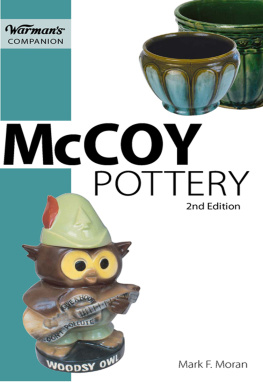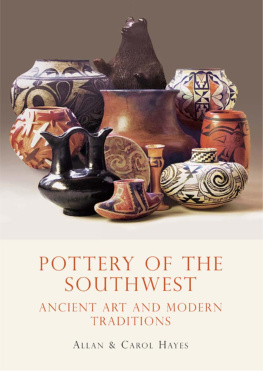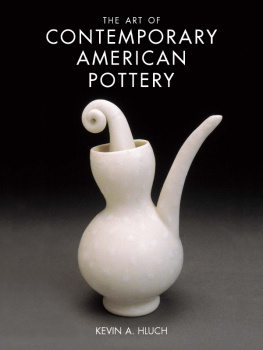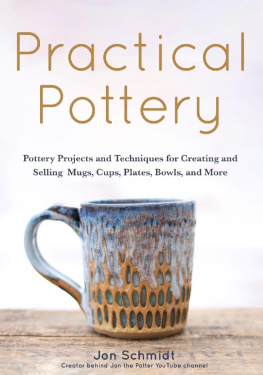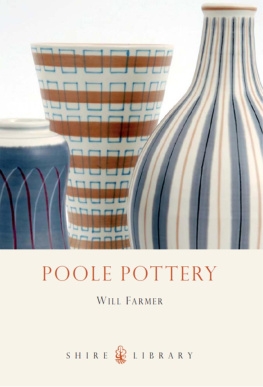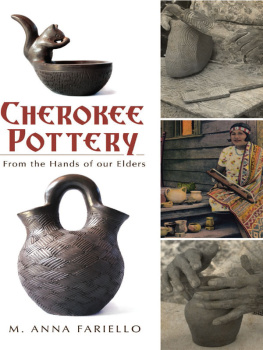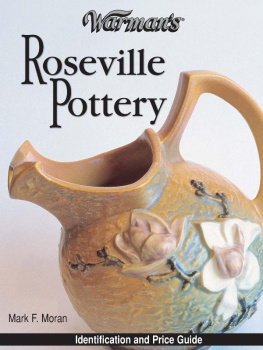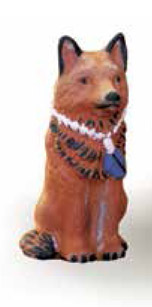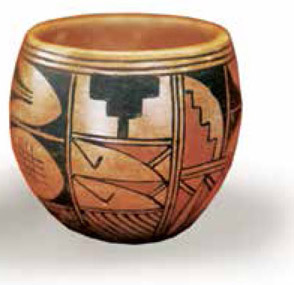ACKNOWLEDGEMENTS
When we wrote this book the first time out, we began by thanking Carol and Brenda, who lived with the insanity day to day. In the following years, Brenda maintained an admirable stiff-upper-lip tolerance, while Carol went past simple tolerance and joined in as a full-fledged co-conspirator.
Next, we acknowledged our two original tour leaders, Al Anthony of Adobe Gallery and salvage archeologist Claire Demaray, who showed us a world that in 1990, we didnt know even existed.
Al Anthony patiently answered all our beginners questions and pointed us toward an understanding of historic and modern pottery. Claire Demaray introduced us to prehistory, and it was largely through their counsel that we were able to do the first edition. They read our manuscript, gave advice and corrected our stupidities. At that time, we tipped our hats to Mark Bahti and Bruce Bernstein, whose comments and suggestions moved the book to a higher level.
During those first years, we walked around carrying a copy of American Indian Art by John W. Barry. It was our first and most important textbook. At the time, we had no idea that Jack and Valerie Barry lived a few miles up the road from us. We met them at an Indian art show, and theyve been fast friends and supporters ever since, always ready to lend their expertise and pass on helpful information without being asked. Weve bought pots from each other, read each others manuscripts and been the beneficiaries of their hospitality and their wisdom time and again.
More people than we can even remember have helped us over the last twenty years, and the best we can do is to start naming some of the names. We should mention potters, some no longer with us, who gave us information and counsel: Robert Tenorio, Elvis Torres, Felecita Eustace, Seferina Ortiz, Bernadette Track, Gloria Trujillo, Flo and Sal Yepa, Stephanie Rhoades (Snowflake Flower), Joseph Latoma, Rosemary Apple Blossom, Toni Roller, Robert Vigil, C. Maurus Chino, Virginia Naranjo, Anthony Durand, Thomas Tenorio, Eva Salazar and Betty Barrackman.
Then there were the experts, dealers and collectors whove contributed knowledge and expertise, beginning with the late Dick Howard, a great mentor, and the auctioneers who taught us: Ron Milam, his son Allen and Ron Munn.
Then, in no particular order, Steve de Priest, Spencer MacCallum, Bob Gallegos, Russ Hartman, Steve and Paul Elmore, Colleen Hicks of the Museum of the American Indian, Kim Martindale, Jeff Hammond, Dwight Lanmon, Andrea Fisher, Kathy Dougherty and Kelley Hays-Gilpin of the Museum of Northern Arizona, Bob Andrews and everyone who worked with him, Anne Woosley, Deborah Ortiz and Laraine Jones of the Arizona Historical Society, Chris Selser, Gary and Patty Klepper, Greg and Angie Schaaf, Jonathan Mabry, Dave de Roche, Walter Parks, Craig Oettinger, Forrest Fenn, Rick and Mary Beth Rosenthal, Edwin Wade, John Hill, Jim Owens and Deborah Hayes, Beth Parvin, Jefferson Reid and Stephanie Whittlesey, Jerry Weisberg, Ramona Morris, Shielah Garcia, Frank Harlow, Erich Erdoes, Victor Ochoa, Bill Beaver, Jay Graham, John Hornbek, Jerry Howard of the Mesa Southwest Museum, Mark Sublette, Marti Struever, Frank and Aurelia Fleck, Mike Holloway, Debbie and Alston Neal, Merlin Carlson, Terry Schurmeier, Dean Barnes, Robert Nichols, Karen Moonitz, Vincent Drucker, Phil Garroway, Duane Anderson, Anthony Ramirez, Mark Arrowsmith, Carl Vincent, Chuck Rozansky, Susan DeMatei, Roy Oswalt, Frank Hill, Michael Eros, Dace Hyatt, Ellen Woods, Eason Eige, Curtis and Margaret Marks, Peter Carl, Jan Musial, Cheryl Crownover, Mark Mackie and some now gone, the late Don Bennett, Bob Brown, Sandy Horn, Gene Lang, Reggie Sawyer, Ron Messick, Herb Puffer, Bob Ashton, Mike Hawley, Michael Kastner and Jack Antle.
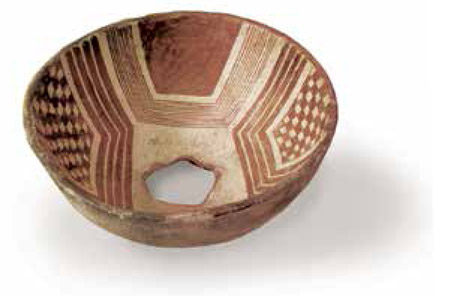
Mimbres Boldface, 7" diameter, circa 975
We also owe a big hat tip to family members. Mark and Keith Hayes helped create the maps and kept our computers working. The book looks the way it does because of their help. From Santa Fe, Heidi Blom and Mert Kenyon guided us through the Pueblos and connected us with new artists.
In the beginning, we thanked Dave Jenney and Northland Publishing for believing in us, and today we owe an equal thanks to Rick Rinehart and Laura Reiter, Sally Craley and Karie Simpson at Rowman & Littlefield, the parent company of Taylor Trade Press. They kept the book alive and in print for nearly twenty years, waited patiently for us to complete this revision, and did everything they could to retain its character.
And finally, a thank-you to the hundreds of others who helped us over the past twenty years and whose names arent on the list.
Thanks, guys. Without you and all youve done for us and given us, this wouldnt be a book.
AFTERTHOUGHT
Als first. Acoma, Evelyn Garcia, 3" high, 1989
Johns first. Hopi, Lunas Navasie, 3" high, 1991
Looking back, several things occurred to us. In 1996, at the end of the first edition, we wrote that we were rather stunned by what had happened.
When we started, we didnt really believe that our benighted quest to cover the subject from A to Zfrom Anasazi and Acoma to Zia and Zunicould come close to the mark. Or that people who had devoted their lives to the study of the subject could have taken two amateurs seriously enough to help with the project.
But perhaps our green enthusiasm was our strong point. A lot of those serious students of the field helped us far more than we ever hoped they would, and many set things aside for us and sold them to us for less than they should have.
We came to realize that, in an upside-down way, we had excellent credentials for writing the book in 1996. We were authentic beginners, and as such, we had a pretty good idea of what beginners needed to know. That might help explain the astonishing going-on-twenty-year longevity of this book.
Maybe it really began with where we made our first purchases.
In 1989, on their first-ever visit to the Southwest, Al and Carol went to Sky City, the ancient Acoma mesa, and bought a souvenir: the greenware puppy on the left.
Two years later, on their third Southwest vacation, Al and Carol talked John and Brenda into joining them. We all went to another ancient settlement, Walpi on Hopis First Mesa, and John bought his first souvenir.
Had we bought our first pieces from a helpful dealer in a nice store somewhere, we might not have felt the connection with antiquity so acutely.
We learned in school that the history of our nation begins with the Pilgrims barely four hundred years ago, but those trips taught us otherwise. Each of us drove a thousand miles across the country and bought an example of a two-thousand-year-old art from an artist in a thousand-year-old village.
That art became so important to us that we devoted a large portion of our lives to it over the next two decades.
What happened to us, and why we fell into this so easily, underscores one of the main propositions of the book: that this pottery is not only one of the worlds important art forms, its also one of the most accessibleso accessible that in just four years, our spare-time hobby turned into a collection that described more than fifteen hundred years of development.
Now its 2015. That collection grew threefold, and many of the new pieces we added were ones we only wished we could find when we wrote the original edition. This new version of the book tells the same story, but with fewer gaps and half-again as many pieces.


